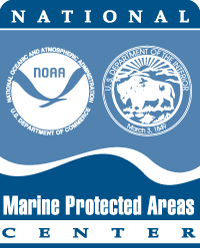Hawaiian Islands Humpback Whale National Marine Sanctuary, Management Plan Review
A Resource by the Marine Protected Areas Federal Advisory Committee (These statements do not necessarily reflect the positions of NOAA or the U.S. Government)

The Hawaiian Islands Humpback Whale National Marine Sanctuary, currently (2014) a site focused on the conservation of a single species, is undergoing a review of its overall management plan as established by the National Marine Sanctuaries Act. This review process engages the public in the identification of other critical marine resource issues specific to the conservation needs of the islands. The importance of cultural heritage resources emerged during the public scoping and input phases of this review. Ultimately, the sanctuary may adopt an ecosystem-based management effort, an approach which includes cultural heritage resources in the evolution of its management efforts.
The Hawaiian Islands feature a wide variety of both tangible and intangible cultural heritage resources. Hundreds of stone coastal fish pond systems (loko i`a), fishing tools and artifacts reflect the original discovery and settlement of the ancient past. The long and intensive history of maritime transportation has led to many historic locations of canoe launching locations, coastal navigational features, historic landings and anchorages, shipwrecks from the sail and steam eras, military vessels and aircraft associated with World War II, and other types of submerged archaeological sites.
Cultural heritage management, though, involves more than just artifacts; it involves locations of significant cultural practices that connect local communities to the sea. These practices include such things as traditional Hawaiian fishing and gathering of marine resources, coastal salt production, and canoe paddling and voyaging navigation. Many locations are referenced in Native Hawaiian folklore and oral histories of major events and figures, and remain culturally important due to the customary knowledge associated with those places. The continuation of traditional practices and the maintenance of this customary knowledge, therefore, rely on the careful consideration and preservation of these specific marine locations.
As part of the review process, the sanctuary has included two descriptive action plans within the Draft Management Plan for both Hawaiian cultural heritage (Living and Evolving Cultural Traditions) and maritime heritage (Maritime Heritage), for public consideration within the draft management plan. These plans were the product of a public working group effort.
DRAFT Action Plan objectives (see DMP for detailed activities):
Living and Evolving Cultural Traditions (Desired Outcome: Ho‘ohawai‘i--foster the uniqueness of Hawai‘i through the understanding of both historical and contemporary local knowledge about coastal and marine environments, and the perpetuation of customary environmental practices and principles within the sanctuary.)
- CT-1: Understand traditional Hawaiian cultural perspectives as related to the natural environment and customary environmental management practices.
- CT-2: Incorporate traditional Hawaiian management practices into sanctuary resource management approaches to ensure place-based management efforts are more relevant to each specific biocultural setting around the Hawaiian Islands.
- CT-3: Facilitate the communication of cultural perspectives on the interconnectedness between traditional Hawaiian practices and natural resource management.
Maritime Heritage (Desired Outcome: NOAA, the State of Hawai'i, partner agencies, businesses and local communities are engaged in the identification and appreciation of maritime heritage resources in Hawai‘i to effectively preserve these resources for the benefit of current and future generations.)
- MH-1: Characterize maritime heritage resources found in sanctuary waters.
- MH-2: Raise awareness and appreciation for the significance of maritime heritage resources within and adjacent to sanctuary waters.
- MH-3: Preserve and protect for future generations the maritime heritage resources found within sanctuary waters.
The attention to cultural heritage resources within the Hawaiian Islands Humpback Whale National Marine sanctuary reflects the priorities of the Native Hawaiian host culture and the public in Hawai`i, and highlights the importance of our many cultural connections to the sea.
 Marine Protected Areas
Marine Protected Areas